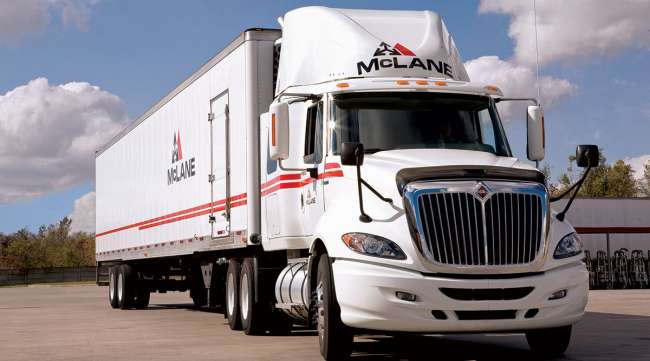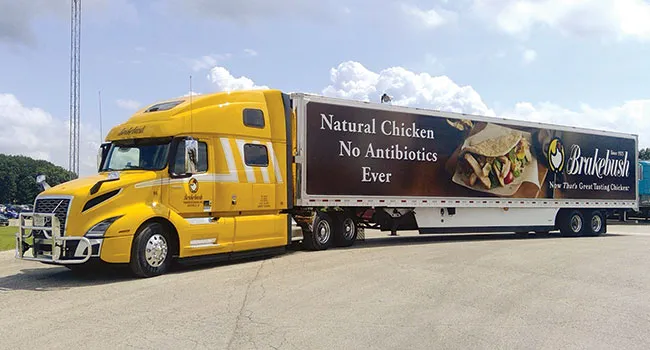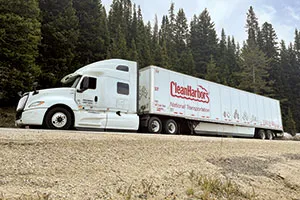Private Fleets Continue Optimization Efforts

[Stay on top of transportation news: Get TTNews in your inbox.]
Private motor carriers, like all trucking operations, have been adjusting to shifting freight market conditions during the past year as truck capacity has loosened and freight rates have softened.
In this business environment, private fleet operators have focused on optimizing efficiency, controlling costs and improving asset utilization, all while maintaining high levels of service.
Private refrigerated carrier Brakebush Transportation Inc., the trucking operation of Westfield, Wis.-based poultry processor Brakebush, handled a spike in volume a year ago when freight capacity was still constrained.
“When capacity gets as tight as it was, which was basically nonexistent, and service failures increase or we see a significant increase in cost, that freight comes back to the private fleet to manage,” said Mike Schwersenska, the fleet’s general manager. “When the switch flips, we have to be ready to act. The inverse is true as well. When the market loosens, that same group of logistics folks are looking and saying, ‘We have trucks that can move this.’ ”
Like many other companies with their own trucking fleets, Brakebush uses a mix of its own private assets along with for-hire carriers to optimize operations and provide the best service. Finding the right combination is a “delicate balancing act,” Schwersenska said.
See the 2023 Top 100 rankings
►Introducing the Top 100 Private Carriers
►Top 100 Private interactive map
►Private Fleets Continue Optimization Efforts
►Sector Rankings Illustrate Market Shifts
►Ashley's Trucking Fleet Keeps Furniture Moving
►Kroger, Albertsons CEOs Detail Proposed Merger
Sector Rankings
Food Service | Grocery
Beverage
Petroleum/Chemical
Industrial Gases | Agriculture/Food Processing
Wholesale/Retail | Manufacturing
Equipment Rental | Building Materials
Waste Management
Paper/Office Products
Construction
Health Care
Uniform Rental
Media & Entertainment
“We’re always looking for ways to adjust and improve the balance based on market conditions and outside factors,” he said, adding that Brakebush also has a freight brokerage division to manage additional volumes.
“If we were just operating in the private fleet bubble, it would be more difficult to adjust and scale when needed,” Schwersenska said.
Private carriers typically haul about two-thirds of their outbound goods, but that amount has increased slightly, said Tom Moore, senior vice president of the National Private Truck Council. “This year, we saw the percentage of the outbound haul go up a couple of points,” he said. “I think private fleets have not given back to the market as much as they took away.”
Despite looser capacity and lower for-hire rates in the current freight marketplace, shippers with private fleets still like the level of control enabled by having their own fleet operations, NPTC President Gary Petty said.
Private fleets don’t necessarily expand or contract based on outside carrier rates, he added.
“Private fleets build capacity based on an all-season model and demand cycles that are scaled to the actual customer,” Petty said. “We don’t build a church for Easter Sunday. We build a private fleet for the entire year.”
Although capacity in the overall freight market has loosened, McLane Co.’s suppliers understand the benefit of McLane controlling the freight, said Todd Tully, vice president of transportation at the food service and grocery distributor.
“We share a common goal of getting their product to our distribution centers as efficiently as possible, and that translates to efficiency and value for all,” he said.
McLane has data and analytics embedded into its processes to help determine which combination of private fleet assets, outside carriers and third-party logistics providers is best at any given time.
“We currently use outside partners strategically to address the needs of certain customers and territories, but maintaining our private fleet is what allows us to offer more personalized service to our customers,” Tully said.
McLane, based in Temple, Texas, ranks No. 8 on the Transport Topics Top 100 list of the largest private carriers in North America.
Loosening capacity hasn’t affected the private fleet operations at truck stop operator Love’s Travel Centers, which handles most of its own transportation needs through its in-house fuel carrier, Gemini Motor Transport.
However, there is an ongoing drive to look at costs and how to make things run smoother.

As business conditions shift, Brakebush carefully balances the amount of freight it hauls with its own fleet versus relying on for-hire carriers. (Brakebush Transportation)
“We are always tweaking and fine-tuning where we can, whether it be new, more efficient equipment or looking at driver and employee metrics,” said Brent Bergevin, vice president of transportation. “It really is a never-ending quest for excellence. We continue to look for the small things that, because of our size and scale, add up to something meaningful.”
Bergevin said that could include automating more office functions or adding new processes to improve drivers’ efficiency.
Oklahoma City-based Love’s ranks No. 32 on the private TT100.
Clean Harbors, which provides waste management and other industrial services, uses its private fleet to execute transportation at the lowest cost for the company.
The fleet works to improve efficiency by eliminating wasted time and making better use of underutilized assets.
“Through key performance indicators, such as maximizing loaded miles, increasing the number of loads per driver, maxing weight/cube per load, etc., we can reduce and control costs,” said Kevin Ridings, executive vice president of transportation and logistics.
We currently use outside partners strategically to address the needs of certain customers and territories, but maintaining our private fleet is what allows us to offer more personalized service to our customers.
Todd Tully, McLane Co.
Image
Clean Harbors, based in Norwell, Mass., ranks No. 14 on the private TT100.
Boosting Asset Utilization And Driver Productivity
The cost of owning, operating and maintaining a trucking fleet means that utilization is paramount for private carriers.
“If you have a fleet, you want to use your fleet,” said Chris Caplice, chief scientist for DAT Freight & Analytics, a load board and data provider for the transportation industry.
“At a macro level, you see dedicated increase during tight markets and decrease when it gets soft, but the contracts are longer term,” he said. “You can’t just shed dedicated, and if you own the trucks, it is even harder.”
A significant component of a fleet’s overall efficiency is the amount of time drivers spend waiting at shipping and receiving facilities.
Caplice said private fleets tend to be more efficient with loading and unloading.
“If I own the truck and the driver works for me, the money comes out of my pocket if I make them wait,” he said. “Being on the same team, you don’t want to waste your co-workers’ time.”
Clean Harbors’ shipping and receiving facilities aim to process drivers within two hours.
“This focus on reducing driver delay ultimately allows us to maximize driver efficiency,” Ridings said, adding that maximizing trailer usage also is a key metric and reduces the number of loads required throughout the network.
Advances in technology also are enabling private fleets to boost efficiency through improved visibility into their operations.
“Clean Harbors has always viewed technology as a competitive advantage, and we’re always finding ways to leverage end-to-end visibility that allows us to maximize our private fleet investment,” Ridings said. “For example, we can easily identify empty miles in our network. We then fill that with our freight or offer it to the market as additional capacity.”

Clean Harbors works to improve efficiency by maximizing loaded miles and minimizing driver delays at its shipping and receiving facilities. (Clean Harbors)
Clean Harbors also is evaluating artificial intelligence features to improve internal load forecasting to maximize load capacity.
Tully said McLane conducts utilization analyses to determine more efficient routes that require fewer miles and driver resources to service customers. Better forecasting allows the company to tighten its routes and reduce equipment, miles and costs.
“We are also improving decision-making in the field to increase efficiency, particularly for specialty roles like routing,” he said.
Brakebush uses software, data and analysis to reduce out-of-route and deadhead miles.
“We run around an 8% deadhead percentage, and our operations team has been working hard to reduce our out-of-route miles, which have always been between 1 and 1.5%,” Schwersenska said.
Brakebush is currently evaluating new technology to further increase its visibility.
“We’ll be able to almost watch a truck go down the road in real time,” Schwersenska said.
The ability to provide real-time updates on loads helps increase efficiency at receiving facilities as well.
“If we can see there is a problem, we can phone ahead to the facility and let them know the load is going to be late. They may be able to switch production around so they don’t have any downtime,” Schwersenska said. “Our main objective is customer service. We’re delivering product to our customer, and we want to make sure they’re getting it at the time they want it and in the condition they want it.”
NPTC’s Moore said private fleets also are moving closer to their customers to help eliminate miles.
“The average mileage continues to drop,” he said.
McLane delivers to nearly every ZIP code across the country. Every time it adds a distribution center, it thinks about the most effective way to put its assets to use.
“We approach the network as a whole to gain visibility and reduce empty miles,” Tully said.
Through key performance indicators, such as maximizing loaded miles, increasing the number of loads per driver, maxing weight/cube per load, etc., we can reduce and control costs.
Kevin Ridings, Clean Harbors
Image
About two-thirds of private fleets have for-hire authority to help fill empty miles, but NPTC’s Moore said that figure is declining.
“Fewer companies have their own for-hire authority, and the percentage of empty miles has gone up to probably a 15-year historic high,” Moore said, explaining that backhauls can’t disrupt private fleets’ service.
Many private fleets are in the direct-store business, which means they have bins, recyclables, returns or waste to haul back.
“It really doesn’t make sense for a lot of our members to be in the backhaul business,” Moore said.
Because Brakebush deals with perishable commodities going into production facilities run on a just-in-time inventory philosophy, the fleet looks at backhauls differently.
“Our goal is to position our assets in locations where we have supply loads,” Schwersenska said. “In delivery locations where we don’t have supplier loads, we are constantly reviewing and adjusting our strategies for securing backhauls to ensure we are operating as efficiently as possible.”
Controlling Costs
To help reduce costs, many private fleets are focusing on fuel economy.
McLane is taking advantage of technology, fuel-efficient vehicles and electrification to minimize fuel and energy costs.
“Fuel-efficient tractors, for example, help us save costs and boost our bottom line,” Tully said. “ESG goals have also pushed manufacturers to develop products and reduce the overall cost of entry for new technologies, which helps us in achieving our own goals.”
Want more news? Listen to today's daily briefing above or go here for more info
McLane uses safety technology, including cameras and event recorders, to monitor driver behavior and proactively identify areas for improvement.
“We have an OEM suite of packages with advanced driver-assistance systems, including features like lane keep assist, alarms and adaptive cruise control,” Tully said.
Overall, loosening capacity has been beneficial to McLane’s fleet operations.
“McLane can purchase more equipment, which has been a significant challenge in the last few years due to supply chain issues,” Tully said. “There has also been an increase in drivers available, which means that we are able to maintain and grow our team, which is how we provide the superior level of service our customers have come to expect from us.”







